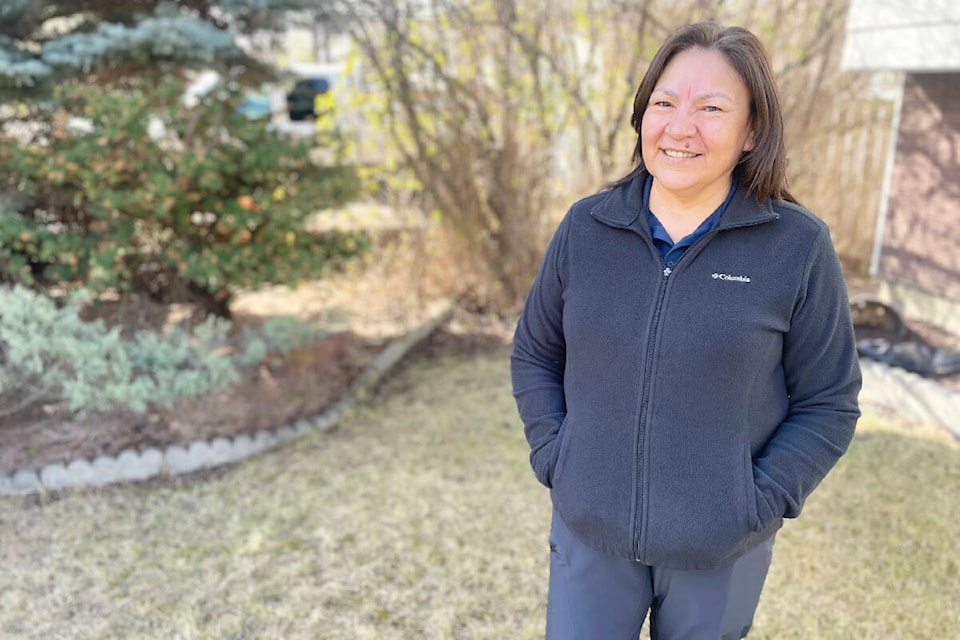Geraldine Elkins is trying to do what she can to make things better for future generations of Indigenous people.
She credits her own parents with sheltering her from much of the inter-generational trauma others in her home community of Tsideldel may have experienced.
Her mom, Minnie Charleyboy and father, the late Patrick Charleyboy, didn’t let her go anywhere alone until she was about 18, with the exception of going to school.
For Kindergarten, then Grade 1, she had to join her two older sisters and one older brother at St. Joseph’s Mission Residential School.
Shortly after beginning school there, however, they were allowed to return home to the Tsilhqot’in. Her youngest brother and her mother were the only two in the family not to have attended St. Joseph’s.
She said she grew up spending time on the land and only learned to speak English thanks to her older brother before going to St. Joseph’s. At home, they spoke Tsilhqot’in. While young she spent a lot of time wanting to leave the remote area where she was raised, now she and her husband Ron Elkins try to get back as much as possible and spend time on Ron’s family’s land near Tl’etinqox, where they have an off-grid cabin.
“I have this belief that people can’t be healthy unless they go back to where their ancestors lived, loved and died,” she explains of her strong connection to the Tsilhqot’in land.
Spending time there and gardening at her home in Williams Lake are how she unwinds from what can be a challenging job as the Cariboo area manager for BC Emergency Health Services (BCEHS), where she started out “on a car” responding to medical emergencies along Highway 20.
“We need to take our spaces in places where people need us,” she said, noting she would love to see all the ambulance stations along Highway 20 staffed by Indigenous people, because they are caring for mostly Indigenous communities.
Being able to help respond to people in need in her own community of Tsideldel is something she found one of the most rewarding parts of the job when she was a paramedic working at stations along Highway 20.
“Sometimes you walk into a house and you’re walking into somebody’s worst day, and you can see the relief when they see me coming through their door and they know they don’t have to have anyone judge them,” she said.
It was the desire to be there for the community which led to her applying for a job with BCEHS.
In 2013, she was living across from the ambulance station in Alexis Creek. She knew it was hard to find staff who would stay out there and she also knew there were many elders at the time who only spoke Tsilhqot’in, which could be a barrier for them when accessing care.
She later went back to school in Kelowna to complete the primary care paramedic program to build on her skills even more to better serve the remote communities. Elkins said she hopes she can help educate other paramedics and first responders in order to support healing the relationship between those in uniform and Indigenous people who are suffering from inter-generational trauma.
She said she was taught by her late father Patrick Charleyboy we can’t change the system until we change it from within.
“I think it’s important that we don’t lead from our traumas,” she said, and instead she said she was taught to lead with compassion, respect and honour.
She has four sons, Nathan, Darryl, and twins, Jayden and Shayden. She and her husband Ron moved into Williams Lake when the twins were going into Grade 10, because she knew from her own experience how hard it can be to board out away from family.
“I wanted to give them the best opportunity that I could offer,” she said.
She fostered the twins, until she could adopt the boys, which was finalized when they were about five. She said in the Tsilhqot’in culture twins are powerful and she wanted to keep the boys together and within a Tsilhqot’in family.
“I can’t say I did it alone it was our whole family,” she said, noting her sisters also helped out, so it was a community effort, which is how it should be, it takes a community.
READ MORE: OUR HOMETOWN: From humble beginnings
READ MORE: HOMETOWN: Lucia Johnston loves ranch life in the Cariboo
Don’t miss out on reading the latest local, provincial and national news offered at the Williams LakeTribune. Sign up for our free newsletter here.
